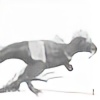HOME | DD
 Saberrex — Eustreptodon
by-nc-sa
Saberrex — Eustreptodon
by-nc-sa

Published: 2013-08-01 17:53:53 +0000 UTC; Views: 1478; Favourites: 28; Downloads: 3
Redirect to original
Description
EustreptodonEustreptodon
Meaning: Well Curved Tooth
Description: Midsize ornithopod
Species: E. goliah
Family: Iguanodontia, Iguanodontidae
Length: 20-25 feet
Lifestyle: Browser
Range: Madagascar
Distinguishing features: A bipedal animal, unlike most of its relatives, this light yellow green dinosaur with fleshy pink nasal sacs, is perhaps the most numerous herbivore in its environment. Found in large groups of up to thirty, this animal lives by a matriarchal hierarchy, where females of any rank are superior to males who are somewhat smaller. The animal is unique among iguanodonts due to its possession of musk glands on its wrists, which they use to tell each other apart, as each animal’s scent is unique. Communication between animals is also highly complex, with a high range of calls ranging from bat-like twitters to earth shaking sub-bass. It is believed that each call has a distinctive meaning for things like available foods or to warn of danger. Males are far more vocal than females and will often challenge each other to fights at any given time, often for sparring practice. Mating among the species is random, occurring at any given time and females will give live birth after about five months to three to seven young. The young grow relatively quickly, maturing at three years old. The males will leave the herd to prevent inbreeding while the females stay behind. They will live for ten to twelve years, perfect for keeping the resources of their island home from wearing out.
Habits and Habitat: Native to all habitats in Madagascar, Eustreptodon is a major herbivore and food source in its environment. More selective in its feeding style than the local saltasaurs, it feeds on the softer, fresher plants that these animals leave behind. It can also often be found around the edges of stegosaur herds. Its narrow muzzle allows it to reach the smaller morsels that these two predators leave behind, and the creatures also prefer fruit, roots, tubers, and on occasion, small fish and lizards as well as carrion, which it eats with little distinction. It is prey for all of the predators of the islands, from large Mahajangasuchid crocodiles to ceratosaurs like Simosaurus and Venatoraptor, the carnosaur Smilocarcharias known as the Blade-shark, and the spinosaur Gorgospinos. Against small predators, it will stand its ground and fight, but against the larger ones, it will flee, zigzagging through thick underbrush or over rocks to frustrate and confuse its attackers. Though not very smart, herds have an uncanny ability to choreograph their flight paths or feeding areas, leading to the concept of “swarm intelligence”, the theory of the animals working as one to fulfill a common goal.




















